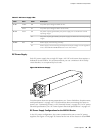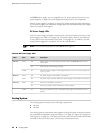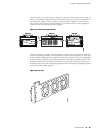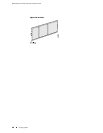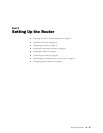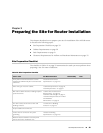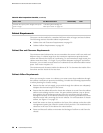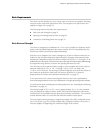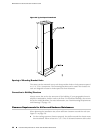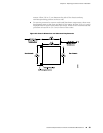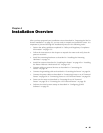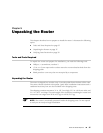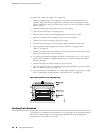
Rack Requirements
The router can be installed in a rack. Many types of racks are acceptable, including
four-post (telco) racks and open-frame racks. An example of an open-frame rack
appears in Figure 20 on page 32.
The following sections describe rack requirements:
■ Rack Size and Strength on page 31
■ Spacing of Mounting Bracket Holes on page 32
■ Connection to Building Structure on page 32
Rack Size and Strength
The router is designed for installation in a 19-in. rack as defined in Cabinets, Racks,
Panels, and Associated Equipment (document number EIA-310-D) published by the
Electronics Industry Association (http://www.eia.org).
With the use of adapters, the router is designed to fit into a 600-mm-wide rack, as
defined in the four-part Equipment Engineering (EE); European telecommunications
standard for equipment practice (document numbers ETS 300 119-1 through 119-4)
published by the European Telecommunications Standards Institute (http://www.etsi.org).
Use approved wing devices to narrow the opening between the rails.
The rack rails must be spaced widely enough to accommodate the router chassis's
external dimensions: 8.71 in. (22.1 cm) high, 24.5 in. (62.2 cm) deep, and
17.45 in. (44.3 cm) wide. The spacing of rails and adjacent racks must also allow for
the clearances around the router and rack that are specified in “Clearance
Requirements for Airflow and Hardware Maintenance” on page 32.
In an open-frame rack, center-mounting the chassis in the rack is preferable to
front-mounting because the more even distribution of weight provides greater stability.
For instructions about installing the mounting hardware, see “Installing the Mounting
Hardware” on page 41.
The chassis height of 8.71 in. (22.1 cm) is approximately 5 U. A U is the standard
rack unit defined in Cabinets, Racks, Panels, and Associated Equipment (document
number EIA-310-D) published by the Electronics Industry Association. You can stack
several MX240 routers in a rack that has sufficient usable vertical space.
The rack must be strong enough to support the weight of the fully configured router,
up to 128 lb (58.1 kg). If you stack multiple fully configured routers in one rack, it
must be capable of supporting the combined weight of the routers.
Rack Requirements ■ 31
Chapter 3: Preparing the Site for Router Installation



